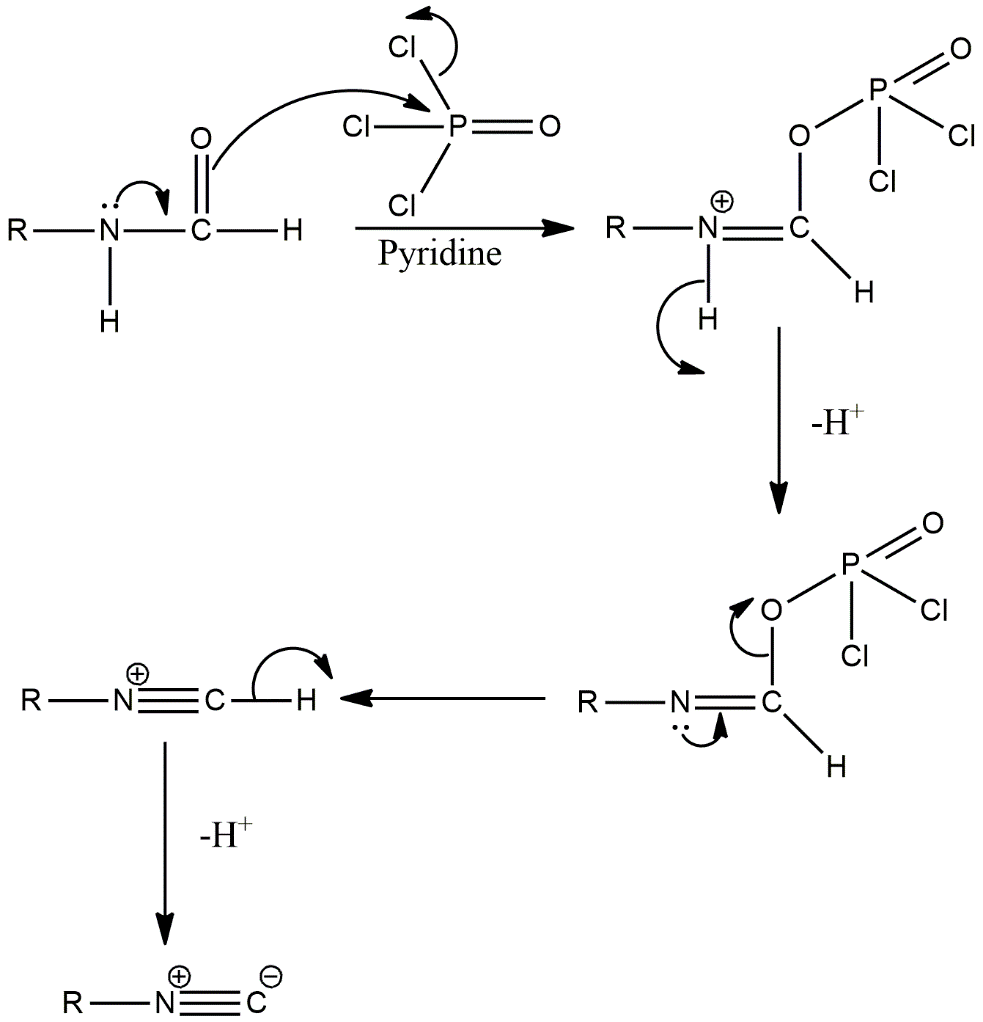
\[R - NH - COH\, \overset{POCl_{3},Pyridine}{\rightarrow} \, Product\]
In the given reaction what will be the product?
A. \[R - N = C = O\]
B. \[R - \mathop N\limits^ + \equiv \mathop C\limits^ - \]
C. \[R - C \equiv N\]
D. None of the above
Answer
225k+ views
Hint: Reaction of amides with \[POC{l_3}\] i.e., phosphorus oxychloride gives nitriles. This is a dehydration reaction as net elimination is of water. Pyridine is a basic solvent used as a solvent in this reaction.
Complete Step by Step Solution:
In this reaction, \[POC{l_3}\] is a dehydrating agent and pyridine is used as a solvent.
The mechanism of the dehydration with phosphorus oxychloride is as follows:
There is lone pair present in the Nitrogen of amide bond of reactant which is delocalized in the amide group and the negative generates on the oxygen of amide group which attacks the phosphorus of \[POC{l_3}\]as phosphorus has empty d-orbitals, then the compound forms which has a positive charge on nitrogen. To neutralise the charge, hydrogen from the nitrogen of the compound gets removed. Then a lone pair of nitrogen is again delocalized to form a triple bond between nitrogen and carbon which results in cleavage of carbon and oxygen bond as carbon valency is four. Now the resultant \[R - \mathop N\limits^ + \equiv C - H\] has acidic proton which will get removed to give the final product \[R - \mathop N\limits^ + \equiv \mathop C\limits^ - \].
The reaction of a compound having an amide functional group with \[POC{l_3}\] and pyridine gives \[R - \mathop N\limits^ + \equiv \mathop C\limits^ - \] product which is option B by the process called dehydration.

Image: Reaction of a compound containing amide bond with phosphorus oxychloride
So, option B is correct.
Note: Phosphorus is from the third period of the p-block element, that’s why it has empty d -orbitals to accept electrons from the surrounding element. Carbon has four valencies, so to maintain its stability, it cleaves the bond with oxygen as \[C - O\]bond is more polar than\[C - H\].
Complete Step by Step Solution:
In this reaction, \[POC{l_3}\] is a dehydrating agent and pyridine is used as a solvent.
The mechanism of the dehydration with phosphorus oxychloride is as follows:
There is lone pair present in the Nitrogen of amide bond of reactant which is delocalized in the amide group and the negative generates on the oxygen of amide group which attacks the phosphorus of \[POC{l_3}\]as phosphorus has empty d-orbitals, then the compound forms which has a positive charge on nitrogen. To neutralise the charge, hydrogen from the nitrogen of the compound gets removed. Then a lone pair of nitrogen is again delocalized to form a triple bond between nitrogen and carbon which results in cleavage of carbon and oxygen bond as carbon valency is four. Now the resultant \[R - \mathop N\limits^ + \equiv C - H\] has acidic proton which will get removed to give the final product \[R - \mathop N\limits^ + \equiv \mathop C\limits^ - \].
The reaction of a compound having an amide functional group with \[POC{l_3}\] and pyridine gives \[R - \mathop N\limits^ + \equiv \mathop C\limits^ - \] product which is option B by the process called dehydration.

Image: Reaction of a compound containing amide bond with phosphorus oxychloride
So, option B is correct.
Note: Phosphorus is from the third period of the p-block element, that’s why it has empty d -orbitals to accept electrons from the surrounding element. Carbon has four valencies, so to maintain its stability, it cleaves the bond with oxygen as \[C - O\]bond is more polar than\[C - H\].
Recently Updated Pages
JEE Main 2025-26 Mock Test: Organic Compounds Containing Nitrogen

JEE Main 2025-26 Organic Compounds Containing Nitrogen Mock Test

JEE Main Chemical Kinetics Mock Test 2025-26: Free Practice Online

JEE Main 2025-26 Organic Compounds Containing Oxygen Mock Test

JEE Main 2025-26 Organic Compounds Containing Halogens Mock Test

Sodium acetate on heating with soda lime produce A class 12 chemistry JEE_Main

Trending doubts
JEE Main 2026: City Intimation Slip and Exam Dates Released, Application Form Closed, Syllabus & Eligibility

JEE Main 2026 Application Login: Direct Link, Registration, Form Fill, and Steps

Understanding the Angle of Deviation in a Prism

Hybridisation in Chemistry – Concept, Types & Applications

How to Convert a Galvanometer into an Ammeter or Voltmeter

Ideal and Non-Ideal Solutions Explained for Class 12 Chemistry

Other Pages
NCERT Solutions For Class 12 Chemistry Chapter 1 Solutions - 2025-26

JEE Advanced Marks vs Ranks 2025: Understanding Category-wise Qualifying Marks and Previous Year Cut-offs

Solutions Class 12 Chemistry Chapter 1 CBSE Notes - 2025-26

NCERT Solutions ForClass 12 Chemistry Chapter Chapter 4 The D and F Block Elements

Biomolecules Class 12 Chemistry Chapter 10 CBSE Notes - 2025-26

NCERT Solutions For Class 12 Chemistry Chapter 10 Biomolecules - 2025-26




